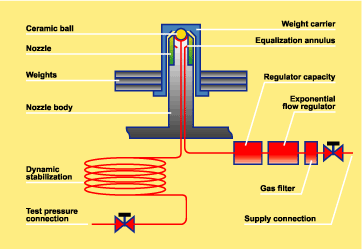Our
pneumatic testers are self-regulating, primary type pressure standards.
An accurate calibrating pressure is produced by bringing into equilibrium the pneumatic pressure on the underside of a ball of known area by weights of known mass on the top. The precision ceramic ball is floated within a tapered stainless steel nozzle. A flow regulator introduces pressure under the ball, lifting it in the tapered annulus until equilibrium is reached. At this point the ball is floating and the vented flow is equal to the fixed flow from the supply regulator. The pressure, which is also the output pressure, is proportional to the weight load. During operation the ball is centered by a dynamic film of air, eliminating physical contact between the ball and the nozzle.
